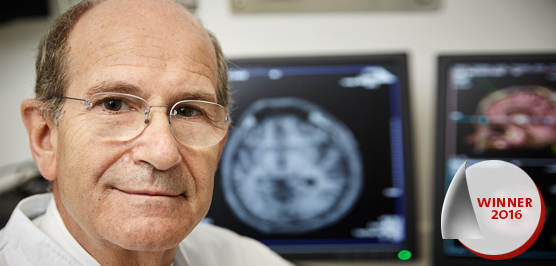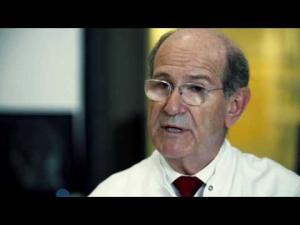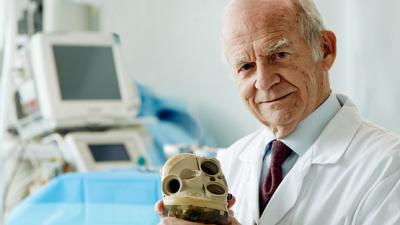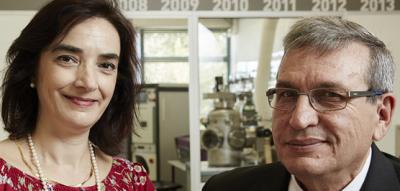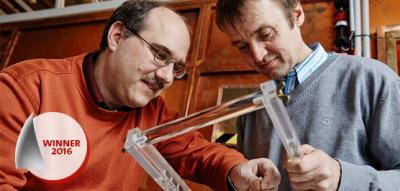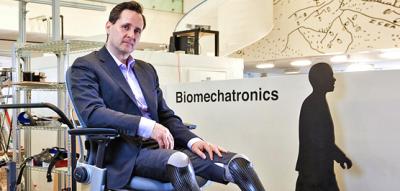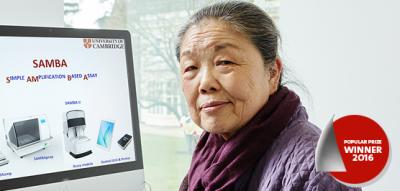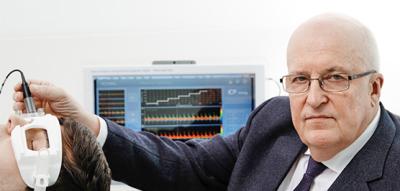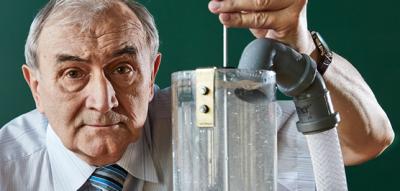Alim-Louis Benabid
Treatment for Parkinson's disease
Winner of the European Inventor Award 2016
The invention by French neurosurgeon and physicist Alim-Louis Benabid of high-frequency deep brain stimulation (DBS) for Parkinson's disease and other neurological conditions has allowed patients around the world to resume functional and fulfilling lives without the need for radical surgeries.
DBS is administered via an electric probe permanently implanted inside the brain, similar to a pacemaker for cardiovascular complications. It has changed significantly how people diagnosed with Parkinson's are treated and their outlook for a high quality of life. Previously, patients suffering from advanced tremor related to Parkinson's disease (PD) would often undergo radical surgeries to create so-called "lesions" - removing entire segments of the brain; a practice dating back to the 1940s. Treatments with dopamine-producing oral drugs proved a gentler alternative, but could potentially worsen symptoms.
As the world's first alternative to lesions and pharmaceuticals, high-frequency DBS was discovered by chance. Performing brain surgery on a patient with PD in 1987, Alim-Louis Benabid inserted an electronic probe into the patient's thalamus, set to a frequency of 50 Hz. When Benabid increased the frequency to 100 Hz, the patient's tremor - a muscle complication associated with advanced PD - subsided entirely. Thanks to this eureka moment, DBS has become the clinical standard for treating advanced PD and conditions such as epilepsy, essential tremor and dystonia.
While DBS at other frequencies was first researched as a method to treat PD in the 1960s, it showed very modest results and was largely abandoned. Benabid reignited interest in the approach after finding the exact high-frequency range that decreased tremor symptoms. He went on to create the associated technology that made the treatment practical.
Societal benefit
The Parkinson's Disease Foundation estimates around 7 to 10 million people worldwide are currently living with Parkinson's disease. Once it has progressed to advanced stages, the disease often prevents patients from maintaining functional lifestyles. The effects of DBS can be life-changing, allowing patients previously immobilised by PD to resume functional, self-directed lifestyles. After receiving CE marking approval for PD treatment in Europe in 1998 and full US FDA approval in 2002, DBS has been administered to over 150 000 patients and has become a standard treatment worldwide.
The initial cost of the procedure yields tremendous paybacks. While the National Parkinson Foundation estimates the cost for DBS surgery at between EUR 31 700 (USD 35 000) and EUR 45 300 (USD 50 000) and upwards of EUR 63 500 to EUR 90 700 (USD 70 000 - 100 000) for bilateral procedures, according to the Movement Disorder Society, the lifetime incremental cost-utility ratio for deep brain stimulation was EUR 6 700 per quality-adjusted life year (QALY).
Economic benefit
Benabid co-founded a start-up company, Clinatec, to bring inventions surrounding DBS to market, including a transcranial fixing device, patented in 2010. The original invention was commercialised in a partnership between Benabid's company Clinatec and Medtronic, an Irish med-tech firm with 85 000 employees and EUR 25.5 billion company turnover in 2014.
The technology is part of a thriving world market for neurological stimulation therapies. A recent study estimates the global neuromodulation market - including deep brain stimulation along with technologies such as spinal cord stimulation, and transcranial magnetic stimulation - at EUR 3.31 billion (USD 3.65 billion) in 2015 (MarketsandMarkets). The market is projected to grow at a CAGR of 11.2% to reach EUR 5.62 billion (USD 6.20 billion) by 2020.
How it works
DBS relies on a surgical procedure during which doctors create a small opening in the skull to insert an electrical probe into the patient's brain. Attached to a lead wire, the probe is worn permanently like a pacemaker, and can then be used to administer electrical charges at controlled intensities of 130 Hz to targeted regions of the thalamus and surrounding areas.
After the discovery of the fundamental principle behind high-frequency DBS, Benabid has improved the state of the art with inventions such as new probes and a transcranial fixing device for securing the guided entry of the DBS electrical probe into the brain through a sleeve with guide shafts inserted at the opening in the skull.
The inventor
Perfectly suited for the world of neurological inventions, Benabid is a rare combination - physicist as well as a neurosurgeon. After earning his medical degree at Joseph Fourier University in Grenoble in 1970, he went on to earn his doctorate in physics in 1978. His unique perspective paved the way for countless improvements on DBS therapeutic devices, including the design of probes, electrodes, and fixation apparatus.
During a medical career spanning more than 45 years, Benabid was staff neurosurgeon at Joseph Fourier University (from 1972), professor of experimental medicine (from 1978), and professor of biophysics from 1983 to 2007. He was also Director of Inserm (French national institute of health and medical research) Unit 318 "Preclinical Neurosciences" from 1988 to 2006.
Benabid has authored 12 granted patents and 523 published scientific papers (H Index of 67). Retired from his long-time position as the head of the Neurosurgery department at the University Hospital in Grenoble in 2007, the avid amateur painter is now emeritus professor of biophysics and chairman of his start-up company Clinatec.
For his lifetime contributions to the advancement of technology in the neurosciences, Benabid has received 23 medals and prizes, including the Robert Pritzker prize from the Michael J. Fox Foundation (2013), the DeBakey clinical medical research award (2014), American Academy of Neurology's Movement Disorders Research Award (2008), and the Breakthrough Prize in Life Sciences (2015). He has been made a knight of the Ordre des Palmes académiques and awarded the French Legion of Honour.
Did you know?
Conventional wisdom names necessity as the mother of invention, but many ground-breaking discoveries owe their existence to chance observations. Benabid happened across the effectiveness of deep brain stimulation at 100 Hz by accident - and used the findings to devise his new treatment approach.
This puts DBS in a league with history-making inventions based on chance discoveries, including Alexander Fleming's discovery of penicillin (1928), Wilhelm Conrad Röntgen's observation of X-rays (1895) and George Nicholas Papanicolaou's invention of the "Pap smear" (1923).
Media gallery
Contact
European Inventor Award and Young Inventors Prize queries:
european-inventor@epo.org Subscribe to the European Inventor Award newsletterMedia-related queries:
Contact our Press team#InventorAward #YoungInventors
